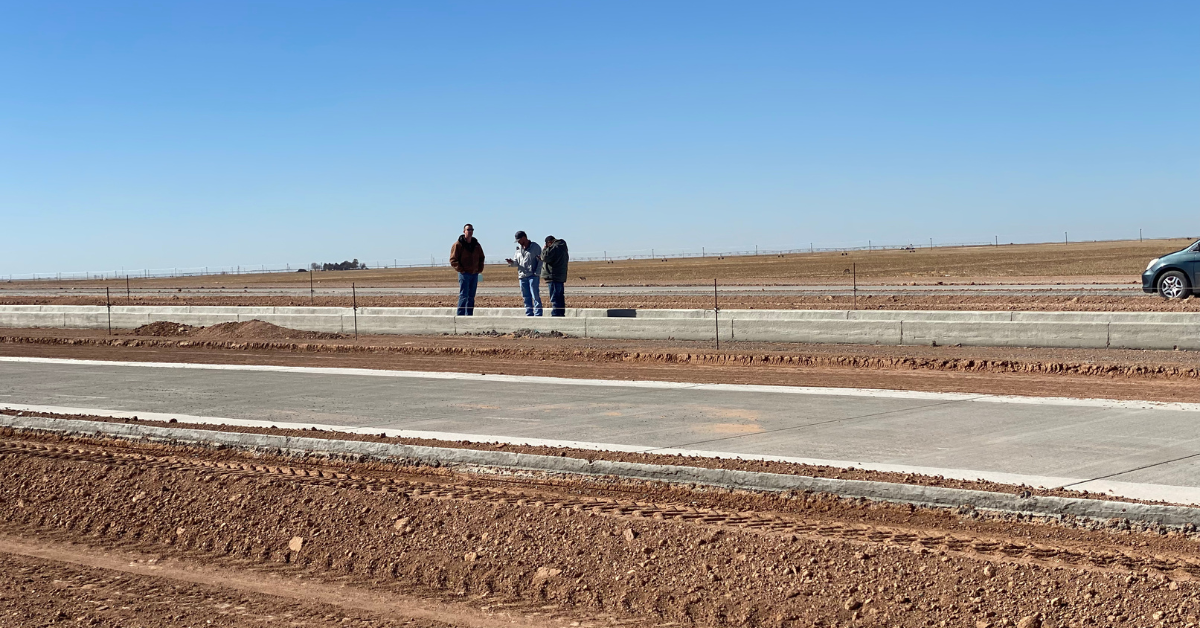
4.21.25
Managing the Mess—Dairy Manure Systems That Actually Work
Part 3: Manure Management Series | MJE, LLC
If you thought manure was messy in feedyards, welcome to the world of dairies—where things get wetter, heavier, and a whole lot more complex. But with the right design? It becomes a sustainable system, not a burden.
At MJE, LLC, we’ve spent decades refining how we build manure management systems for dairies. It’s not just about waste—it’s about water recovery, nutrient recycling, bedding solutions, cow comfort, and biogas opportunities. And when it’s done right? The impact is felt across the entire operation—from animal health to labor efficiency.
More Flush, More Flow, More Planning
Dairy manure is high-moisture, and managing it starts with barn and lane design. These systems flush two to three times per day, often aligned with milking schedules. That means every lane, culvert, and basin has to be sized right—and built to last.
“Unlike feedyards, dairies flush every time cows leave the pens to be milked,” explains MJE Project Manager Aaron Albers. “So if a culvert is undersized or a pump goes down, the whole system backs up—fast.”
Flush systems rely on:
- Proper slope and grading
- Appropriately sized culverts and lanes for scrapers and vac trucks
- Smart tank and water storage placement
- Reliable separators and sand lanes to keep solids moving and water reusable

Clean Design = Healthier Cows
What does all this have to do with the cows? Everything.
Without proper manure flow, dairies end up with standing water, wet bedding, and slick surfaces—all of which contribute to:
- Hoof issues and lameness
- Higher rates of mastitis
- Increased stress and injury risk
- More antibiotics, less production
“Designing a dairy with cow comfort in mind isn’t a luxury—it’s a production strategy,” says Albers. “Cleaner lanes and better bedding mean healthier cows, fewer treatments, and more milk in the tank.”
The Sand Lane Secret
At one large flush dairy, MJE implemented a multi-stage sand separation and recovery system. The process begins with flush water carrying bedding sand and manure into a slow-moving concrete sand lane. Because sand is heavier, it settles—while manure and water flow onward.
From there:
- Sand is recovered, dried, and reused as bedding.
- Manure-heavy water continues to separators and settling basins.
- Water is filtered, returned, and used again in the flush cycle.
The result? Less waste, cleaner barns, and major cost savings on bedding.

Waste Into Water: Smart Recycling Systems
Water is a precious commodity. That’s why MJE designs dairies with reclaim loops—letting dairies pump clean water back to flush tanks for reuse.
In some of the largest dairies we’ve built, this water is flushed, cleaned, and reused multiple times a day, dramatically reducing water consumption and lagoon overload.
Bedding Innovation
Manure separators aren’t just about cleaning water—they’re also helping dairies reuse solids as bedding.
Depending on system design, dairies can:
- Reuse dried manure fiber as cushion on top of rubber mats
- Create bedding filler for fiber barns
- Or stick with sand recycling for a consistent and proven solution
This approach cuts costs and improves cow comfort with softer surfaces and better hygiene.
From Flush to Fuel: Biogas Integration
Some of the most advanced dairies are now turning manure into renewable energy. With covered lagoons, microbes digest the solids and emit methane, which is captured and converted into natural gas.
These systems:
- Reduce lagoon cleaning needs
- Create an entirely new revenue stream
- Reuse water for flushing
- Reduce the carbon footprint of the operation
“The goal is sustainability,” says Albers. “We’re helping dairies get there with systems that do more than just move manure—they power the next stage of ag.”
Designed for Scale, Built for Growth
MJE has designed and built dairy systems that serve thousands of cows and tens of thousands of gallons per day. We don’t just build infrastructure—we build scalable, efficient, cow-friendly systems.
That means:
- Fewer breakdowns
- Cleaner water
- Healthier cows
- Happier operators
“We’ve built systems that serve dairies milking over 15,000 cows per day—where a poorly designed flush loop can cost thousands by lunch.”
What’s Next?
In Part 4, we’ll explore how composting and nutrient recycling can turn manure into a marketable resource—and how to make it pencil out for your operation.
💩 Missed a post? Catch up now!
- Part 1: Manure Management Matters
- Part 2: The Smart Way to Manage Feedyard Manure